 Sindh is the land of Civilizations, the land of incessant invasions and battles. Indus river flows through the high valleys rising from Tibetan Plateau, the glacial waters of Ladakh, cutting fiercely through the highest mountainous regions of Himalayas and Karakoram. It huge water mass flows through the heart of Pakistan, once cradle of the famous Indus Valley Civilization existing 4500 years ago. It was a vibrant, highly civilized community, subsisting along its banks. The well organized communities maintained a constant contact with other civilizations existing in Mesopotamia, Iran and Central Asia. Then a wave of nomadic hordes of Aryan migratory tribes in 1500 BC replaced these communities with a lasting affect on the cultural and ethnic outlook of the region as far as Indo-Gangetic plain.
Sindh is the land of Civilizations, the land of incessant invasions and battles. Indus river flows through the high valleys rising from Tibetan Plateau, the glacial waters of Ladakh, cutting fiercely through the highest mountainous regions of Himalayas and Karakoram. It huge water mass flows through the heart of Pakistan, once cradle of the famous Indus Valley Civilization existing 4500 years ago. It was a vibrant, highly civilized community, subsisting along its banks. The well organized communities maintained a constant contact with other civilizations existing in Mesopotamia, Iran and Central Asia. Then a wave of nomadic hordes of Aryan migratory tribes in 1500 BC replaced these communities with a lasting affect on the cultural and ethnic outlook of the region as far as Indo-Gangetic plain.Though the settled towns of Indus valley Civilization were wiped but its rich cultural heritage never gave way to invaders, rather it got amalgamated into the barbaric onslaught with far reaching historical and cultural impact in the daily life of its people. Ajrak as a fabric is one of the unique example of rich Indus Valley heritage, surviving since 4500 years. This wonder fabric maintains its ancient designs and methods of processing and that has not altered even today. Ajrak is so inspiring a textile which leads us deeper into Sindhi culture in many ways, into their rich resonating music inspired by the great Sufi poets whose sweet words indulges one into the trance of one-ness.
Making of the Ajrak is long process through which a piece of cloth undergoes the love and dedication of its master showing off his generational art of cloth stamping. Ajrak is a full story in itself and to see the making of this magnificent art work is a great merit of human intelligence whose strength dates back to our early historical times.
We shall see an amazing episode of Ajrak making visiting the remote parts of Sindhi desert towns and villages. Then also various handicrafts and meeting with the families involved in the making of their art works. We shall see Sindhi embroidery works on dress panels, traditional caps and shawls. The glasswork will include colorful bangles, laquer work on house furniture and pottery works will give us deep insight into the pure arts of Sindhi folk life. The most interesting aspect is to see the families involved in generational work which is giving fast to modern techniques but local awareness is infusing a new dimension in the folk art by protecting and helping the families. Sindh has been known for its traditional crafts with deep love and feeling of the artists. Its crafts embedded in traditions go with the daily life of its creator. The love for music resonates with artistic activity of Sindhi folk life in the realm of serene deserts.
Itineraries
Day 01: Arrive Karachi – Flt

Meeting on arrival, assistance and transfer to your hotel
Welcome Dinner at local restaurant!
Meet an expert on Sindhi Textiles – an audio visual presentation an introduction of Sindhi Textiles and folk crafts.
The main topic of the talk will be Ajrak the wonder fabric of Sindh
Overnight
Welcome Dinner at local restaurant!
Meet an expert on Sindhi Textiles – an audio visual presentation an introduction of Sindhi Textiles and folk crafts.
The main topic of the talk will be Ajrak the wonder fabric of Sindh
Overnight
Day 02: Karachi
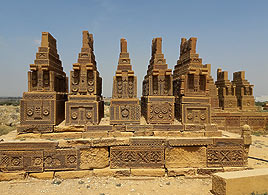
This morning we shall spend visiting the local market exploring stores selling local textiles.
Also we shall visit the traditional bazaars and National Museum – the ethnic gallery with collection of textiles and fabric.
Afternoon excursion to Chaukundi tombs – the wide necropolis is unique for its floral fret work.
in red sandstone. Some tombs are exceptional in design which we shall observe in Ajrak printing and embroidery work.
Overnight
Also we shall visit the traditional bazaars and National Museum – the ethnic gallery with collection of textiles and fabric.
Afternoon excursion to Chaukundi tombs – the wide necropolis is unique for its floral fret work.
in red sandstone. Some tombs are exceptional in design which we shall observe in Ajrak printing and embroidery work.
Overnight
Day 03: Karachi – Thatta – Hyderabad – 165 kms
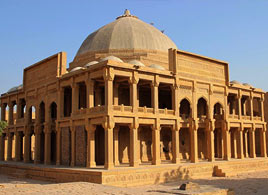
Morning depart for Hyderabad via the old National Highway – we shall make our first stop at
Thatta and Makli. We shall visit 16th century Shah Jehan’s mosque and later visit the
necropolis of Makli Hill. The tombs are excellent examples of fret work on red sandstone,
reflective of traditional Sindhi floral and geometric patterns. We shall visit the local handicraft.
centers to see Sindhi embroidery of Thatta. Later continue to Hyderabad and on arrival transfer to hotel. Short ride of the old town visiting some local shops.
Overnight.
centers to see Sindhi embroidery of Thatta. Later continue to Hyderabad and on arrival transfer to hotel. Short ride of the old town visiting some local shops.
Overnight.
Day 04: Hyderabad – Matiari – Hyderabad
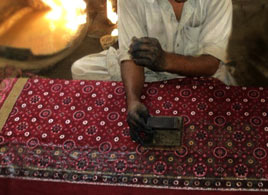
We shall make an extensive excursion to see the process of Ajrak making. This will be a pre-
arranged visit to the workshop one of the local master with a descriptive show of the stamping process of Ajrak making.
Ajrak Cloth from the Soil of Sindh (by Noorjehan Bilgrami)Nature plays an important role in the making of Ajrak. The craftsmen work in total harmony with their environment, where the sun, river, animals, trees and mud are all part of its making. Cloth is torn into sheets and taken to the river to be washed. The damp cloth is then coiled and placed on top of a copper vat and the bundle covered with a quilt to prevent the steam from escaping. This vat is heated by a log fire, through the night and the next day. The steam opens the pores of the cloth and makes it soft so that the impurities can be easily cleansed. This process is called Khumbh. In the next stage, called the Saaj, the fabric is soaked in a mixture of camel dung, seed oil and water. The dung enables the cloth to become softer and acts as a bleaching agent. This stage is very crucial in determining the quality of an ajrak. The wet cloth is then tied into an airtight bundle and kept for 5 -10 days, depending upon the weather. A distinct smell of mango pickle emanating from the bundle confirms that the fibers have been well soaked with oil. The cloth is then dried in the sun and it goes through another oil treatment. The oil is curdled with Carbonate of Soda solution and the cloth is soaked in this mixture to ensure that the fibers receive maximum oil. After a thorough wash in the river the next day, they are soaked in a mixture of Sakun made with Galls of Tamarisk, dried lemons, molasses, castor oil and water. The women usually prepare this mixture at home. Till now the cloth was only given a base preparation. The wet cloth after drying is then brought to the workshop for printing. At this point I shall digress a little to talk about the wooden blocks. They are carved from the Acacia Arabica trees, indigenous to the Sindh region. The repeat pattern, which gives the design its character, is determined by a grid system. The pattern is first transferred to the block and then carved with great precision by the block-maker, who uses very simple tools. The blocks are carved in pairs that can register an exact inverted image on the other side. Today, there is only one surviving member of a family of block-makers whose forefathers were skilled in this craft. The cloth goes through the first indigo dye, which unfortunately, is now synthetic indigo, as the usage of natural dyes had been abandoned over 50 years ago. Usually the master-dyer, known as the Usto himself does the dyeing in the vat. The dyed cloth is then taken to the river the next morning before sunrise. All the sheets are submerged in the water for at least an hour. To a rhythmic count, the craftsmen swish and thrash the ajraks in the water for an hour or more until the gum and the excess dye have been washed off and the white areas become clear. Printing of the Kiryana, the outline resists to remain white after dyeing. In a large copper vat the ajraks are dyed with alizarine (no longer in madder – Rubia Cordifolia). Heated by log fire the craftsman diligently lifts and immerses the cloth repeatedly for a couple of hours till the desired red color is reached. Soaking of ajraks in Sakun solution on the banks of the river, for tapai, the red ajraks are spread out to partially dry in the sun, the artisan scoops the water to sprinkle on the cloth. The alternate drying and drenching of the cloth bleaches the white areas and deepens and matures the other colors. This continues for a couple of hours before they are washed, dried and then taken to the workshop. The mud resist mixture is again printed to cover the red areas and immediately sprinkled with the sifted, dried, cow dung to dry the wet areas, called meena. The thick, mud-encrusted cloth is folded and slowly lowered in the indigo vat for the second time. The ajraks are dried, rolled into a bundle and then taken to the river for the final wash. The craftsmen fold the ajraks while still damp and the weight presses them as they become dry. Will there be a continuity of this ancient laborious craft tradition? The younger generation is seeking more lucrative work that is less labor-intensive with short-term gains. Some are taking short cuts by reducing the number of essential stages in the making; others simply have switched to printing cheap silk-screen versions. The continuity of ajrak has persisted over centuries only because it is an integral part of Sindhi culture. Its usage is evident at all levels of society and the cloth is held in high esteem with the utmost respect given to it. I hope we can together give protection to preserve this amazing process and the ancient craft tradition. Video link a documentary about making of Ajrak: https://youtu.be/mZmwyVHbeIU https://www.youtube.com/watch?v=irbYdUK-UTQ&t=551s |
Day 05: Hyderabad – Mithi – 210 kms
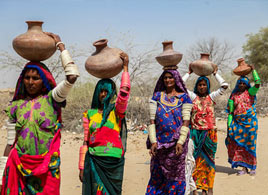
Today we shall depart for Mithi deeper into Thar Desert – on arrival after settling in our Guest House we start exploring Thar desert communities – this will be drive on desert roads deeper in the desert to visit local communities living in traditional thatched huts of mud. We shall have the opportunity to see the making famous rilli a bed spread of patch work and also see desert embroidery work. On arrival after check-in at Marvi Motel we shall leave for the town visit Mor Handicraft Centre – this is a store will large collection of patch work, embroidery on dresses, handbags, table cloth, wall and ground spread
Thar is inhabited by ethno religious Muslim and Hindu communities spread out in large deserttract. Deeper in the desert communities live in hamlets of thatched roofed huts. People subsist on small scale farming dependent on rainfall and often gets worst in dry months. Thar extreme weather causes families to move to more near water resources so many make shift farm lands are wide spread in the region. However few settled villages with scarce population keep their way of life supported by moveable farming habits.
The diverse nature has given resilience to local folks who live under trying weather extremities. In Thar we shall be exploring local community based handicrafts mainly Thari embroidery which is colorful bright and symbolic effected by its daily life and surroundings.
Return to our base of Mithi at the end of the day
Overnight
The diverse nature has given resilience to local folks who live under trying weather extremities. In Thar we shall be exploring local community based handicrafts mainly Thari embroidery which is colorful bright and symbolic effected by its daily life and surroundings.
Return to our base of Mithi at the end of the day
Overnight
Day 06: Mithi – Hala – Sehwan – Manchar lake – 368 kms
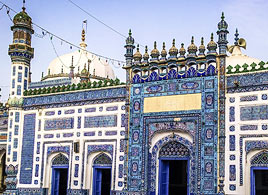
Morning depart for Sehwan taking the route via Hyderabad – we shall make first stop at the
town of Hala. Our visits to include workshops of local pottery making, handlooms producing
traditional textiles and etching on lacquered wood work.
Next we shall visit 17th century shrine of famous Sufi Saint Shah Abdul Latif with elaborate décor of local blue tile work while the interior of the tomb is colorfully painted.
Later we shall continue to Manhar Lake and on arrival transfer to lakeside motel It will be great to see the sun setting views on the lake which has large number of boat people living in boats on the lake
overnight
Next we shall visit 17th century shrine of famous Sufi Saint Shah Abdul Latif with elaborate décor of local blue tile work while the interior of the tomb is colorfully painted.
Later we shall continue to Manhar Lake and on arrival transfer to lakeside motel It will be great to see the sun setting views on the lake which has large number of boat people living in boats on the lake
overnight
Day 07: Manchar Lake – Moenjodaro – Sukkur – 252 kms
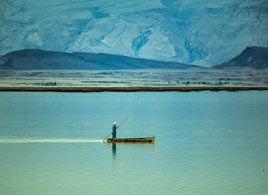
In the morning we shall visit the boat people who are born, live and die on the boat houses.
Manchar is a fresh water lake and people live on the water subsisting on fishing which is now on the decrease due pollution but Mohanas, the boat people keep their centuries old life style of living on the water in old traditional way. We shall take the opportunity of meeting a Mohana family and share with them their experiences of life on the water.
Later we shall proceed to Moenjodaro, one of the prime site of Indus Valley Civilization which thrives along the banks of river Indus some 2500 BC. While we drive through the villages we may see that life has not changed much as the same old bullock carts are still being used.
The statue of the famous Chief Priest wearing an Ajrak was found here. We shall visit local museum and the site in detail with local expert.
After a short break we shall continue to reach Sukkur our next stop.
Overnight
The statue of the famous Chief Priest wearing an Ajrak was found here. We shall visit local museum and the site in detail with local expert.
After a short break we shall continue to reach Sukkur our next stop.
Overnight
Day 08: Sukkur
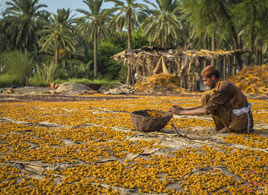
Today we shall spend a hectic day in Sukkur exploring and visiting local handicraft workshops for traditional Sindhi embroidery work and later visit local shop selling embroideries for dresses, pillow covers, bed sheets and rillies the applique work.
In the afternoon we shall make excursion to Khairpur – we shall be visiting the date farms and see procurement and drying of date fruit. We shall also visit 18th century Kot Diji Fort sitting on pre Harappan site 3300 BC. The fort was built by powerful Talpur rulers of the region and we shall have a chance to visit 18th century Faiz Mahal or Faiz Palace of Talpurs
Return to Sukkur in the late afternoon
Overnight
Return to Sukkur in the late afternoon
Overnight
Day 09: Sukkur – Bahawalpur – 387 kms
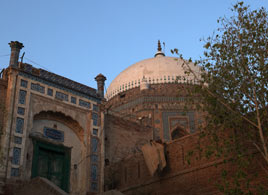
Morning depart for Bahawalpur enroute we shall make stop to visit Uch Sharif – the medieval city which has history even dating back to 326 BC when Alexander the Great after defeating Raja Porus at the battle of Elephants, marched downwards to the point of the joining of five rivers. This was significant moment and deciding factor where Alexander the Great faced mutiny when his soldiers, weary of war refused to carry further on to his Indian expedition/Alexander the Great succumbed to the pressure and ordered homeward march but dispatched Nearchus, the admiral to find the mouth of Indus and join him in Persia. He himself followed the river course for a while before moving westward into Gedrosia, experiencing harsh terrain and weather losing a section of army to heat.
In Uch Sharif we shall visit the classical tombs of local rulers with wonderful tile work and continue to Bahawalpur. After check-in we shall make short evening tour of the town visiting the palace of the last Emir of Bahawalpur.
Overnight
In Uch Sharif we shall visit the classical tombs of local rulers with wonderful tile work and continue to Bahawalpur. After check-in we shall make short evening tour of the town visiting the palace of the last Emir of Bahawalpur.
Overnight
Day 10: Bahawalpur – Multan – 100 kms
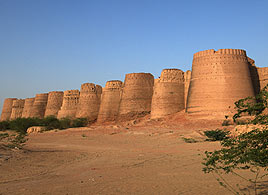
This morning we shall make excursion to Fort Derawar in the desert – we shall visit the tombs of the old Nawabs or rulers of former Bahawalpur State, also visit the Abbassi Mosque with its intricate Jaipur marble work. Later depart for Multan and on arrival after check-in we shall do do a walking tour of the old bazaar of Multan
Overnight
Overnight
Day 11: Multan
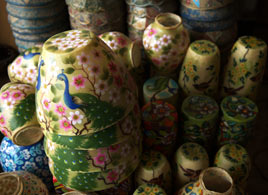
This will be our activity day filled with local handicraft workshops visit: Multan is known for its handicraft which has deep rooted connection with Persian floral patterns. In the first half we shall dedicate to local textiles visiting local handloom industry. This will also include visiting display of Multani embroidery and applique work. Later we shall visit local pottery works, wood carving workshops, camel skin products and local tile works. We shall be visiting local stores to hunt for old and new hand made textiles, desert embroideries in bed sheets, dress apparel, handbags, cushion covers and local embroidered caps - Overnight
Day 12: Multan – Lahore – 339 kms
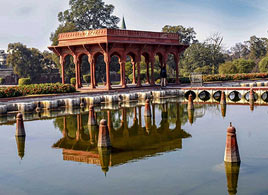
Morning depart for Lahore with short stops enroute – on arrival at lunch time we shall leave
soon after check-in for our first city sightseeing tour. Lahore is known for its rich culture and great Mughal heritage. We shall be visiting the famous Shalimar Gardens and Lahore Museum
Overnight
Overnight
Day 13: Lahore
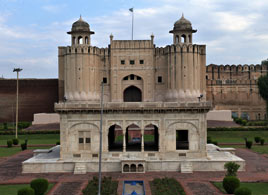
Full day dedicated to the visit of Mughal monuments to include the great Badshahi Mosque, Lahore Fort the best example of the development in Mughal architecture in different stages. Later visit Jehangir’s mausoleum Afternoon will be dedicated to old part of Lahore city which has not changed through centuries with its vibrant bazaars full local color and flavor.
Overnight
Overnight
Day 14: Lahore – Depart
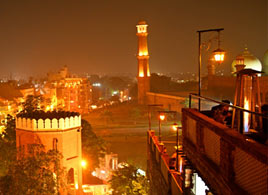
Transfer to airport for your destination flight
Gallery
View the embedded image gallery online at:
https://ahutravelntourism.com/index.php?option=com_content&view=article&id=236&Itemid=670#sigProId46e9a957cd
https://ahutravelntourism.com/index.php?option=com_content&view=article&id=236&Itemid=670#sigProId46e9a957cd




